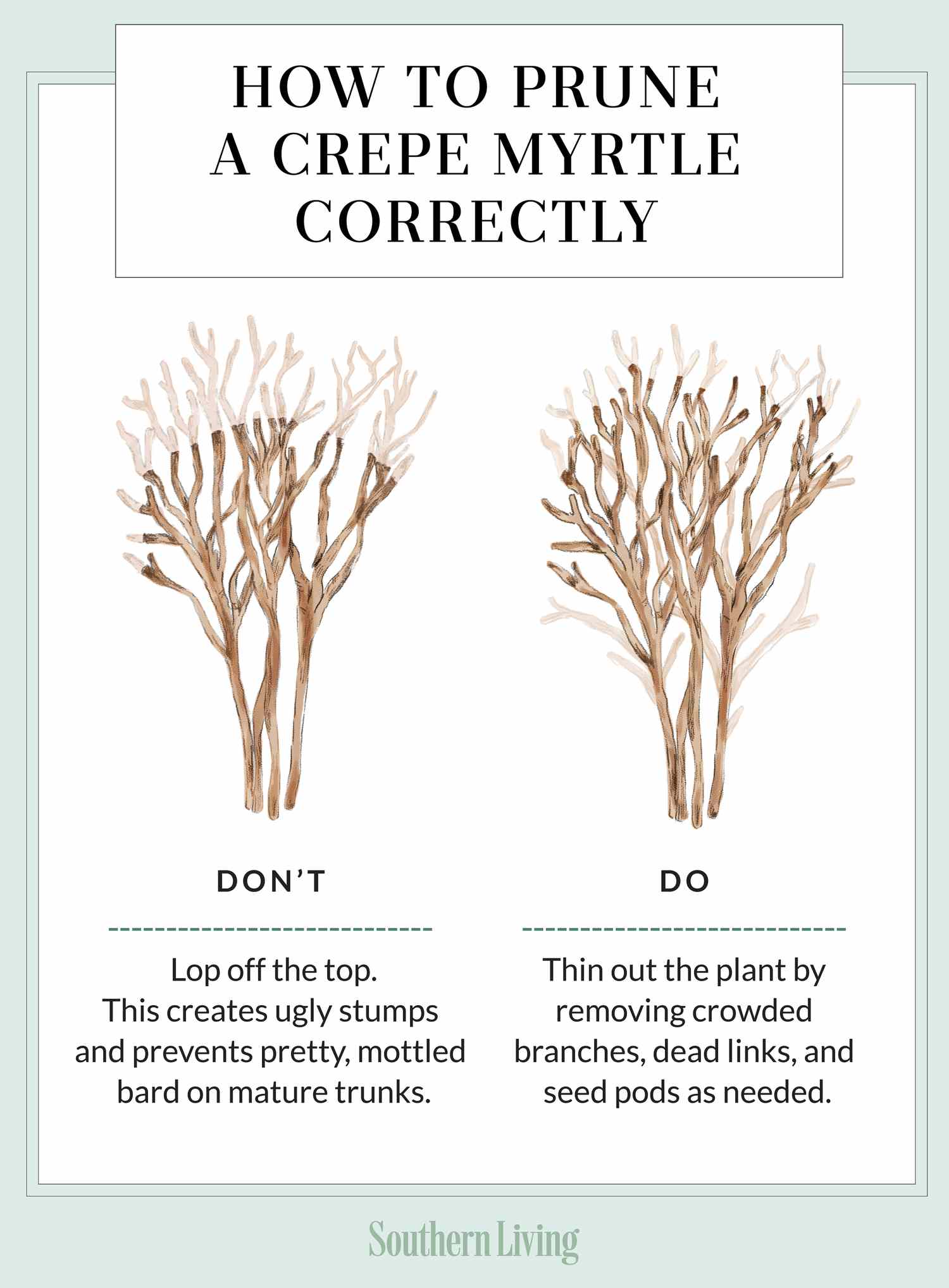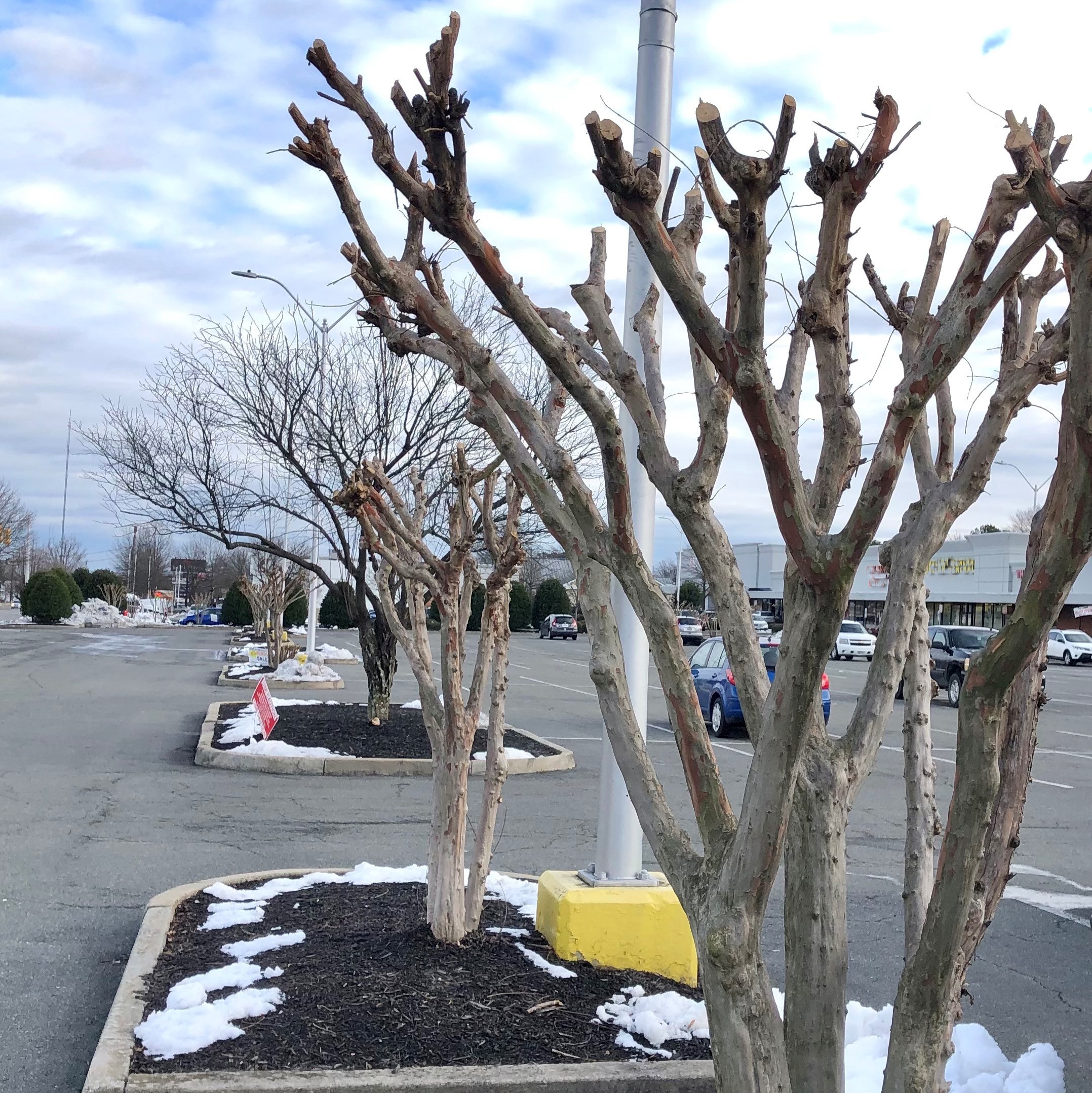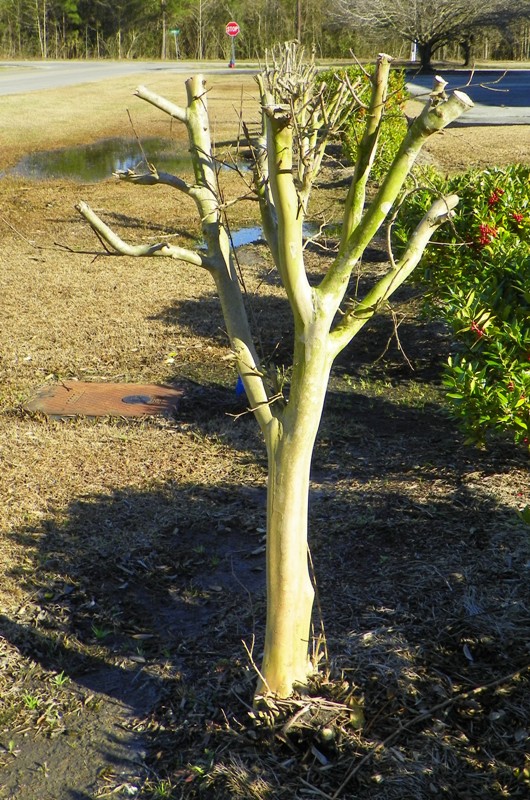
Pruning Techniques for Crape Myrtles: Expert Tips for Lush Blooms
Prune crape myrtles in late winter or early spring. Remove dead branches and shape the plant for better growth.
Crape myrtles are popular for their vibrant blooms and easy maintenance. Proper pruning ensures healthy growth and beautiful flowers. Pruning involves removing dead or diseased branches and shaping the plant. This process encourages new growth and increases flower production. Always use sharp, clean tools to make precise cuts.
Avoid over-pruning, as it can stress the plant. Aim to maintain the natural shape of the crape myrtle. Regular pruning in late winter or early spring keeps the plant healthy and visually appealing. By following these techniques, you can enjoy a flourishing and attractive crape myrtle in your garden.
Introduction To Crape Myrtles
Crape Myrtles are a popular choice for gardens. These plants are known for their vibrant flowers and attractive bark. They thrive in warm climates and require minimal care. Proper pruning enhances their beauty and health.
Overview Of The Plant
Crape Myrtles are deciduous trees or shrubs. They can grow up to 30 feet tall. Their flowers bloom in summer and come in various colors.
Here are some key features:
- Flowers: Pink, red, white, purple, and lavender
- Bark: Smooth, peeling in layers
- Leaves: Green, turning red or orange in fall
These plants are often used in landscaping. They are drought-tolerant and can grow in different soil types.
Importance Of Pruning
Pruning is crucial for Crape Myrtles. It helps maintain their shape and encourages new growth. Proper pruning prevents diseases and removes dead branches.
Here are some benefits of pruning:
- Improves air circulation: Reduces the risk of fungal infections
- Enhances flowering: More flowers bloom with proper pruning
- Promotes healthy growth: Removes weak and crossing branches
Pruning should be done during late winter. This ensures the plant’s energy is focused on new growth in spring.
| Pruning Task | Time of Year |
|---|---|
| Removing dead branches | Late winter |
| Shaping the plant | Late winter |

Credit: www.lewisginter.org
Best Time To Prune
Knowing the best time to prune crape myrtles ensures healthy growth. Pruning at the right time encourages more blooms and prevents diseases. Below, we dive into the seasonal guidelines and climate considerations for pruning crape myrtles.
Seasonal Guidelines
Winter is the ideal time to prune crape myrtles. The trees are dormant, making it easier to see their structure. Pruning in winter helps prepare the tree for spring growth. Avoid pruning in late summer or fall as this can lead to frost damage.
Spring pruning can also be effective but must be done early. This allows the tree to focus energy on new growth. Late spring pruning can reduce the number of blooms.
Avoid pruning in summer and fall. Pruning during these seasons can weaken the tree. It can also make it vulnerable to pests and diseases.
Climate Considerations
Pruning times can vary based on your local climate. In warmer regions, winter pruning should be done in late winter. In colder regions, prune crape myrtles in early spring to avoid frost damage.
| Climate | Best Pruning Time |
|---|---|
| Warm Regions | Late Winter |
| Cold Regions | Early Spring |
- In hot climates, prune in late winter.
- In cold climates, prune in early spring.
Always adjust pruning based on your region’s specific climate. This ensures optimal health and bloom for your crape myrtles.
Essential Tools
Pruning crape myrtles requires the right tools. Using the proper tools makes the job easier and keeps the plants healthy. This section covers the essential tools needed for effective pruning.
Pruning Shears
Pruning shears are crucial for cutting small branches and stems. They are perfect for branches up to half an inch thick. Ensure your shears are sharp to make clean cuts. Clean cuts help the plant heal faster. Always sanitize your shears after use. This prevents the spread of diseases.
Loppers And Saws
Loppers are used for thicker branches. They can cut branches up to two inches thick. Loppers have long handles, giving you extra leverage. This makes cutting easier and safer.
For even thicker branches, use a pruning saw. These saws are designed to cut through wood easily. Choose a saw with a comfortable grip. A comfortable grip reduces hand fatigue during long pruning sessions.
| Tool | Use | Branch Size |
|---|---|---|
| Pruning Shears | Small branches and stems | Up to 0.5 inches |
| Loppers | Thicker branches | Up to 2 inches |
| Pruning Saw | Very thick branches | Over 2 inches |
Using the right tools ensures the health and beauty of your crape myrtles. Keep your tools clean and sharp for the best results.

Credit: pender.ces.ncsu.edu
Step-by-step Pruning Process
Pruning crape myrtles can seem challenging, but with a step-by-step process, it becomes manageable. Proper pruning promotes healthy growth and enhances the tree’s beauty. Follow these steps to prune your crape myrtles effectively.
Preparation Steps
- Gather Your Tools: You will need pruning shears, loppers, and a saw.
- Inspect the Tree: Look for dead, diseased, or damaged branches.
- Plan Your Cuts: Decide which branches need to be removed.
- Wear Safety Gear: Protect your eyes and hands with gloves and goggles.
Cutting Techniques
- Remove Suckers: Cut off the small shoots at the tree’s base.
- Thin the Crown: Trim the interior branches to allow light and air.
- Eliminate Crossed Branches: Remove branches that rub against each other.
- Shape the Canopy: Prune to maintain the desired shape and size.
| Tool | Usage |
|---|---|
| Pruning Shears | For small branches and fine cuts |
| Loppers | For medium-sized branches |
| Saw | For thick, heavy branches |
By following these steps, you can ensure your crape myrtles remain healthy and beautiful. Pruning helps the tree grow strong and bloom better. Always use clean, sharp tools to make precise cuts.
Common Mistakes
Pruning crape myrtles can be tricky. Many gardeners make common mistakes. These mistakes can harm the plant. Proper pruning enhances growth and beauty. Let’s explore some common errors.
Over-pruning
Over-pruning is a frequent mistake. Pruning too much weakens the plant. It can lead to fewer flowers. Over-pruning also makes the plant more prone to disease.
Here are some signs of over-pruning:
- Too many branches cut off
- Stunted growth
- Fewer blooms
To avoid over-pruning, follow these tips:
- Prune no more than one-third of the plant
- Use sharp tools for clean cuts
- Prune during the dormant season
Improper Cuts
Improper cuts can damage your crape myrtle. Cuts in the wrong place harm the plant. They can lead to disease and poor growth.
Common types of improper cuts include:
| Type of Cut | Description |
|---|---|
| Flush Cuts | Too close to the trunk |
| Topping | Cutting main branches too short |
| Stub Cuts | Leaving too much branch behind |
To ensure proper cuts, remember these points:
- Cut just outside the branch collar
- Avoid cutting main branches
- Use clean, sharp tools
Advanced Pruning Techniques
Advanced pruning techniques for crape myrtles can greatly enhance their health and beauty. These methods ensure the trees maintain their structure and promote vibrant blooms.
Thinning
Thinning helps improve air circulation and light penetration. Remove dead or crossing branches. Cut them back to their base or a main stem. This keeps the tree healthy and strong.
- Identify the branches that are too crowded.
- Use clean, sharp pruning tools.
- Cut branches at a 45-degree angle.
Thinning prevents diseases and pests. It also encourages the growth of larger, more vibrant flowers.
Heading Back
Heading back controls the size and shape of the crape myrtle. This technique stimulates new growth and promotes blooming.
- Select the branches that need shortening.
- Cut them back to a bud or side branch.
- Ensure each cut is just above a node.
Heading back should be done carefully. Avoid cutting too much, as this can stress the tree. Regular heading back helps the tree maintain its desired shape.
| Technique | Benefits | Steps |
|---|---|---|
| Thinning | Improves air circulation, prevents disease |
|
| Heading Back | Controls size, stimulates growth |
|
Maintaining Tree Health
Pruning techniques for Crape Myrtles are essential for maintaining tree health. Healthy trees bloom better and resist pests and diseases. Proper care ensures that your Crape Myrtles thrive. Let’s explore key areas to maintain tree health.
Fertilization Tips
Fertilization helps Crape Myrtles grow strong and healthy. Use a balanced fertilizer in early spring. Apply a slow-release granular fertilizer for best results. Too much nitrogen can reduce blooms. Follow the instructions on the fertilizer package. Water the tree well after fertilizing. Avoid fertilizing late in the season to prevent frost damage.
Pest And Disease Control
Pest and disease control is crucial for healthy Crape Myrtles. Regularly inspect your trees for pests like aphids and Japanese beetles. Use insecticidal soap or neem oil to treat infestations. Prune infected branches to prevent disease spread. Ensure good air circulation around the tree. Remove fallen leaves and debris to reduce disease risk.
| Pest | Control Method |
|---|---|
| Aphids | Insecticidal soap |
| Japanese Beetles | Neem oil |
- Inspect regularly for pests and diseases.
- Use natural treatments like insecticidal soap.
- Maintain good air circulation around the tree.
- Remove fallen leaves and debris.
Encouraging Lush Blooms
Pruning crape myrtles correctly can lead to lush, vibrant blooms. This section provides essential tips to ensure your crape myrtles flourish. Let’s explore the steps for success.
Watering Practices
Proper watering is crucial for healthy crape myrtles. These trees need deep watering to thrive. Ensure the soil is moist but not soggy.
- Water early in the morning.
- Check soil moisture regularly.
- Avoid watering the leaves.
Use a soaker hose to water deeply. This helps the roots grow strong. Deep roots lead to more blooms.
Sunlight Requirements
Crape myrtles love sunlight. They need at least six hours of direct sunlight each day.
- Choose a sunny spot in your garden.
- Avoid planting in shady areas.
Sunlight helps crape myrtles produce more flowers. Ensure they get enough light for vibrant blooms.
Follow these steps for lush, beautiful crape myrtle blooms.
Aftercare Tips
After pruning your crape myrtles, proper aftercare ensures healthy growth. Following specific aftercare tips can help your plants thrive and bloom beautifully. Below, we outline some essential tips to follow.
Monitoring Growth
Keep an eye on your crape myrtles after pruning. Regularly check for new growth and any signs of stress. This includes watching for discolored leaves or wilting branches.
| Growth Stage | Action |
|---|---|
| Initial Weeks | Ensure proper watering. |
| First Month | Look for new shoots. |
| Following Months | Check for pests and diseases. |
Adjusting Techniques
Sometimes, you need to adjust your pruning techniques based on plant response. If your crape myrtles show weak growth, consider lighter pruning next time. Strong growth might require more aggressive pruning.
- Observe the plant’s response.
- Adjust the pruning severity accordingly.
- Always use clean and sharp tools.
Properly monitored and adjusted techniques ensure your crape myrtles remain healthy and vibrant. Keep a close eye and make necessary changes for the best results.

Credit: www.lsuagcenter.com
Frequently Asked Questions
How To Prune Crape Myrtles Correctly?
To prune crape myrtles correctly, remove dead and crossing branches. Trim suckers at the base. Thin out interior growth. Shape the canopy. Avoid topping.
Do You Cut Crepe Myrtles Above Or Below The Knot?
Cut crepe myrtles just above the knot. This promotes healthy growth and prevents disease. Always use clean, sharp tools.
Why Do They Cut The Tops Off Crepe Myrtles?
People cut the tops off crepe myrtles to control their size and shape. This encourages new growth and more blooms. Proper pruning improves air circulation and sunlight penetration. Avoid over-pruning to prevent weak growth.
Do Crepe Myrtles Need Pruning After Flowering?
Yes, prune crepe myrtles after flowering to shape and remove dead branches. This encourages healthy growth and more blooms.
Conclusion
Pruning crape myrtles can enhance their beauty and health. Follow these techniques to achieve stunning results. Regular pruning promotes growth and vibrant blooms. Remember to use clean, sharp tools and prune at the right time. Your crape myrtles will reward you with a beautiful display.
Happy gardening!

